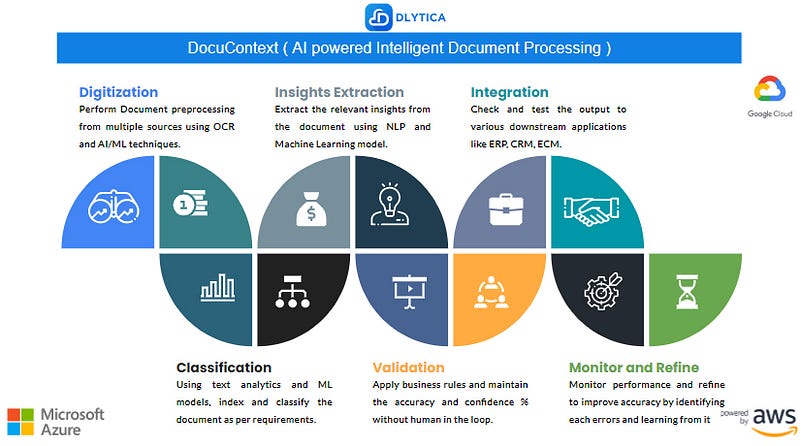How DocuContext can help Insurance Company?
Overview
The insurance industry generates a vast amount of unstructured, semi-structured and structured documents in the form of policies, claims, and customer information. With the advancement of technology, it has become easier to process and manage this data. DocuContext ( AI Intelligent Document Processing ) is a technology that automates data entry and extraction from documents using artificial intelligence and machine learning algorithms. In this blog, we will explore the top use cases of DocuContext [Current + Future scope ] in the insurance industries.
Learn more about DocuContext here : https://www.dlytica.com/product/docucontext/

Use cases of DocuContext in Insurance:
- Claims Processing
Claims processing involves the analysis and verification of a wide range of documents, including claims forms, medical records, police reports, and more. DocuContext can help automate this process by using OCR (Optical Character Recognition) to read the documents and then using NLP (Natural Language Processing) to extract relevant data such as policy number, claim amount, and date of loss. This can help insurance companies reduce the time and cost associated with claims processing and improve the accuracy of the process. - Underwriting
Underwriting involves the assessment of risk associated with potential policyholders, which often requires analyzing a variety of documents such as policy applications, medical records, and driving records. DocuContext can automate this process by extracting relevant data from these documents, which can then be used to make more informed decisions about the risks associated with a particular policyholder. This can help insurance companies streamline the underwriting process and reduce the time it takes to decide. - Policy Administration
Policy administration involves the management of policy documents such as endorsements, renewals, and cancellations. DocuContext can help automate this process by using OCR to read the documents and then using NLP to extract relevant data. This can help insurance companies reduce manual errors and improve the accuracy of policy administration. - Fraud Detection
Fraud detection involves identifying and preventing fraudulent claims, which can be challenging due to the complex nature of the claims process. DocuContext can help by using machine learning algorithms to analyze documents such as medical bills, police reports, and witness statements, and flagging potential instances of fraud. This can help insurance companies identify fraudulent claims and reduce their losses. - Risk Assessment
Risk assessment involves evaluating the level of risk associated with a particular policy or policyholder, which often requires analyzing documents such as property appraisals, inspection reports, and credit reports. DocuContext can automate this process by extracting relevant data from these documents, which can then be used to make more informed decisions about the level of risk associated with a particular policy or policyholder. This can help insurance companies make more informed decisions when underwriting policies. - Customer Onboarding
Customer onboarding involves the process of bringing a new customer on board, which often requires analyzing a variety of documents such as ID proofs, tax forms, and employment records. DocuContext can help automate this process by extracting relevant data from these documents, which can then be used to streamline the onboarding process and reduce the time it takes to bring a new customer on board. - Document Management
Document management involves the organization and indexing of documents such as policies, claims forms, and invoices. DocuContext can help automate this process by using OCR to read the documents and then using NLP to extract relevant data, which can then be used to organize and index the documents more efficiently. This can help insurance companies reduce the time and cost associated with manual document management. - Compliance
Compliance involves ensuring that insurance companies are meeting all regulatory requirements, which often requires analyzing documents such as legal agreements, contracts, and regulatory filings. DocuContext can help automate this process by extracting relevant data from these documents, which can then be used to ensure that the insurance company is meeting all regulatory requirements. - Claims Investigation
Claims investigation involves analyzing various documents such as police reports, medical records, and witness statements to determine the validity of a claim. DocuContext can help automate this process by using machine learning algorithms to analyze the documents and flag potential instances of fraud. This can help insurance companies reduce the time and cost associated with claims investigation.
Immediate Benefits of DocuContext
- Increased Efficiency
DocuContext can automate the data entry and extraction process from documents, which can improve the speed and accuracy of processing. This can reduce the time and effort required to process claims, policies, and other documents, which can increase efficiency and productivity. - Improved Accuracy
DocuContext uses artificial intelligence and machine learning algorithms to extract data from documents. This can reduce the risk of errors associated with manual data entry and improve the accuracy of the data. - Cost Savings
DocuContext can reduce the time and effort required to process documents, which can lead to cost savings. Automation can reduce the need for manual labor, which can result in reduced labor costs. - Better Compliance
DocuContext can help insurance companies comply with regulatory requirements by automating the data entry and extraction process from compliance documents. This can reduce the risk of compliance errors and improve the efficiency of compliance management. - Enhanced Customer Experience
DocuContext can speed up the claims processing time, which can improve the customer experience. Faster claims processing times can lead to higher customer satisfaction and retention rates. - Fraud Detection
DocuContext can help identify potential cases of fraud by identifying inconsistencies in the data extracted from claim documents. This can improve the accuracy of fraud detection and reduce the risk of fraudulent claims.
In conclusion, DocuContext ( AI Intelligent Document Processing ) offers several benefits to the insurance industry. By automating data entry and extraction from documents, DocuContext can increase efficiency, improve accuracy, reduce costs, improve compliance, enhance the customer experience, and improve fraud detection. These benefits make DocuContext an essential technology for the insurance industry in the digital age.
Conclusion
In conclusion, DocuContext ( AI Intelligent Document Processing ) is a powerful tool for the insurance industry. By automating data entry and extraction from documents, DocuContext can improve accuracy, speed up processing times, and reduce errors. The top use cases of DocuContext in the insurance industry include claims processing, policy administration, underwriting, fraud detection, and compliance. As the insurance industry continues to digitize its operations, DocuContext will become an essential technology for managing the growing volume of data.
What’s next?
Want to learn more.
We have number of solutions to help you to modernize your Data Warehouse.
1. Free Data Architecture Consultation
2. Pay as you go data resources
3. Robotic Process Automation
4. Data Warehouse Solution
5. Big Data and BI
Visit our website and contact us today.
Contact us today to learn how can Dlytica help you for your next step.
Contact Us : https://www.dlytica.com/contact-us/
Official Site : https://www.dlytica.com/
Linkedin : https://www.linkedin.com/company/dlytica/
Recent Post
Why Enterprises Are Choosing DataNature over Cloudera, Databricks, and Snowflake? Across Canada, banks, telcos, and public-sector organizations a [...]
Empowering businesses with unified data, intelligent automation, and real-time insights. Introduction: How an AI Data Platform Drives Enterprise [...]
Introduction Artificial Intelligence (AI) is quickly changing industries, and this is most obvious in the finance and banking worlds. From fraud [...]
Introduction In today’s digital environment, data-driven technologies are reshaping how companies operate. Every day, organizations produce enorm [...]
Introduction Customer data is growing at lightning speed, but making sense of it remains a challenge. This is where AI agents in customer analyti [...]
Introduction Big Data and AI are transforming the way businesses handle massive datasets. In today’s fast-paced digital world, organizations stru [...]
Introduction The Banking and Financial Services (BFSI) industry is at the edge of a major transformation. With rising customer expectations, incr [...]
Introduction In the rapidly evolving world of technology, the development of customized Large Language Models (LLMs) is a frontier being explored [...]
Introduction: In the rapidly evolving technology landscape, Data and Artificial Intelligence (AI) are reshaping industries and revolutionizing bu [...]
Introduction: Language is the glue that connects us in this digital age. From chatbots that converse with us to virtual assistants that understan [...]
In the modern business landscape, data is the new oil, powering decisions and strategies across sectors. Dlytica Inc., with its cutting-edge data [...]
Data Analyst: A Data Analyst scrutinizes numeric data to aid companies in making informed decisions. They are often the entry point for individua [...]
Introduction Collision 2023, the largest AI event of the year, served as a vibrant hub of innovation, collaboration, and knowledge-sharing. In th [...]
Overview Intelligent Document Processing (IDP) is an Artificial Intelligence (AI)-driven technology that is rapidly transforming the way business [...]
Overview In today’s fast-paced business world, companies generate a vast amount of data, most of which is stored in paper-based or unstructured d [...]
Overview The insurance industry generates a vast amount of unstructured, semi-structured and structured documents in the form of policies, claims [...]
Overview Intelligent Document Processing (IDP) refers to the use of Artificial Intelligence (AI) technologies to automate the data extraction pro [...]
In the digital age, businesses are constantly looking for ways to streamline their operations and increase efficiency. One area that holds great [...]
Overview: Intelligent Document Processing (IDP) refers to the automated process of analyzing, extracting, and categorizing data from various type [...]
Introduction: Cloud computing is a technology that allows users to store, access, and manage data and applications over the internet. Instead of [...]
Introduction to Resource Augmentation IT resource augmentation services are a growing trend in the business world, as organizations look for ways [...]
Introduction to Data Warehouse A data warehouse is a centralized repository of structured and organized data that is used for reporting, analysis [...]
Overview: Robotic process automation (RPA) is a software technology that makes it easy to build, deploy, and manage software robots that emulate [...]
How can AI automate Insurance Industry? In this article, you will learn : What is Insurance Claim Process Automation? Claims Processing is t [...]
What is CMAP? One of the premium solution provided by Dlytica is Cloud Migration Acceleration program (CMAP).Migrate to cloud with our suppo [...]
With an Innovative team at DLytica, we work on converting your Data Strategies to Solutions. We leverage a team of skilled Data Architects, Data [...]
Who are we? Company’s tagline : Drive your business with Data Analytics and AI with DLytica Inc. With an Innovative team at DLytica, we [...]
Overview: Fraud is evolving and nowadays it looks more like organized crime with international and cross-functional teams involved. It means that [...]
